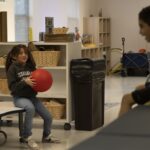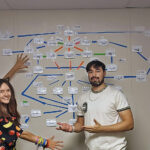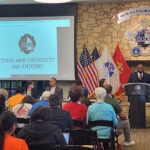By Bobby Martinez/ @bmartinez203
For 19 hours over the course of two days, Texas A&M University-San Antonio’s cyber security team rapidly typed on computers and shouted across large tables in a valiant effort to win a regional cyber competition.
This year’s Southwest Regional Collegiate Cyber Defense Competition on March 7-8 brought nine teams from four states from the southwest, but only one team was chosen to advance.
A&M-San Antonio’s Cyber Security Athenaeum (CSA) did not claim first place in the competition, but now reflects on what the competition taught them.
“I think we could have worked things better,” said team captain Rufus Reed. “At the same time I did not know what I was getting into.”
Top 3 winners
First Place – University of Texas at San Antonio
Second Place – University of Tulsa
Third Place – Texas A&M University in College Station
The cyber team challenged to imagine themselves working under pressure in the real world, maintaining and defending a company’s IT network.
The competition differs from hacking cyber tournaments. Team members don’t show off their skills by hacking into systems.
Instead, they deal with real world scenarios such as creating security policies to block outside threats. These students are the next generation to protect businesses such as Target, Sony and Home Depot who have become victims to cyber breaches.
“Having actual Cyber-Defense experience is huge in today’s jobs market, be it in government, the tech industry, or banking,” said Commander Jan Ketchum, executive officer of SPAWAR 1010. “Also, there comes great satisfaction in being able to take a computer network that was in a shambles and to be able to thwart Red Team’s attacks.”
SPAWAR was one of the sponsors for the competition who participated as the orange team by providing injects. Injects are information received from CEO, employees or end-users that need to be fulfilled.
Behind the firewall
The university’s cyber team, made up of junior and senior level students, faced many obstacles, dead ends and uncertainties during the competition.
Computer science senior Victor Williams, worked intensely on getting a computer fixed throughout the competition. On day two, he suddenly got up from his chair and walked over to an empty carpet area to lie down for a bit. Others stepped in trying their hardest to get it running. Someone called Williams back over, at which point he popped right up and went back to work.
“He was probably trying to think the situation (through).” Reed said “Victor was trying to work on the DNS (server). That is one of the services that we never were able to get going. That was what he has been planning for, prior to the competition.”
However, Reed believes their first inject of the competition was a major factor to their performance.
Inject number one, let teams know they are receiving passwords to log into their systems. CSA responded when they were ready. Thirty minutes and six injects later, they had not heard anything about passwords, so sent one of their team members to investigate. Still, no passwords.
“We set a runner and he came back with a note saying no passwords,” Reed said. “So we had to break into all the systems and that kind of threw us out of a groove. It’s tough.
Feelings not aside
The results disappointed Reed.
Every 15 minutes, teams were awarded points if they were running and zero points for down services.
He felt his team did well, because they kept key services running, such as File Transfer Protocol. File Transfer Protocol is used to transfer computer files from one host to another.
Because of this he thought they would place.
Advice for the future
Every year, teams enter the Southwest Regional Collegiate Cyber Defense Competition blind to challenges. Some pieces of advice are timeless, they agree. Both Matt Weeks, head of the red team member (hacker), and Commander Ketchum of the orange team agree that teams need to focus more on fulfilling inject requests.
Injects can reflect what a CEO might ask of his IT team in the real world and there are consequences if they cannot be completed.
“What teams need to realize is that they work for the CEO and CIO (Computer Information Officer),” Ketchum said. “If they blow off the requests from the bosses in real life, or give smart aleck replies, they will probably be looking for work elsewhere.”
Reed says if he can compete again, he would focus on being more of a leader. He was in the trenches with his team members fighting, when he knew he should have been guiding them and keeping them organized.
Regardless of the winners, sponsors are looking for the best and brightest student who can fit in with their team.
“This was the second CCDC event I have participated in, and I am always impressed by the competition,” Ketchum said. “It makes me feel better that these cyber athletes are out there and working in the public and private sector.”






